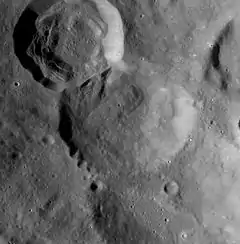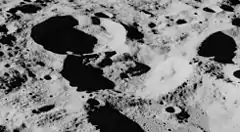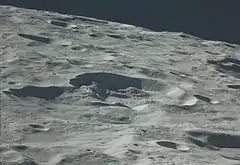Van Gent (crater)
Van Gent is a lunar impact crater on the far side of the Moon that is located to the south-southeast of the larger crater Konstantinov. About an equal distance to the east-southeast is Spencer Jones and to the southeast is Papaleksi.
 LRO image | |
| Coordinates | 15.4°N 160.4°E |
|---|---|
| Diameter | 43 km |
| Depth | Unknown |
| Colongitude | 200° at sunrise |
| Eponym | Hendrik van Gent |


This crater joins the satellite crater Van Gent X to the northwest to form a double crater. Van Gent also partly overlies what appears to be an older crater remnant to the southeast. This in turn is joined to Van Gent N, which is joined to Van Gent P along its southeastern side. The result is a crater chain of sorts, consisting of five craters forming an arc with the concave side facing to the west.
The rim of Van Gent is slightly distorted from a circle due to the craters with which it has formed. The rim edge is somewhat worn, and a small craterlet lies along the shared rim with Van Gent X. The interior is relatively featureless, marked only by a few tiny craterlets.
The crater is the final resting place of Chinese micro-satellite Longjiang 2, which was crashed there in mid-2019.
Satellite craters
By convention these features are identified on lunar maps by placing the letter on the side of the crater midpoint that is closest to Van Gent.
| Van Gent | Latitude | Longitude | Diameter |
|---|---|---|---|
| D | 16.3° N | 161.7° E | 35 km |
| N | 13.5° N | 160.0° E | 32 km |
| P | 12.6° N | 159.4° E | 47 km |
| T | 15.5° N | 157.2° E | 16 km |
| U | 17.0° N | 157.1° E | 20 km |
| X | 16.4° N | 159.7° E | 38 km |
References
- Andersson, L. E.; Whitaker, E. A. (1982). NASA Catalogue of Lunar Nomenclature. NASA RP-1097.CS1 maint: ref=harv (link)
- Blue, Jennifer (July 25, 2007). "Gazetteer of Planetary Nomenclature". USGS. Retrieved 2007-08-05.CS1 maint: ref=harv (link)
- Bussey, B.; Spudis, P. (2004). The Clementine Atlas of the Moon. New York: Cambridge University Press. ISBN 978-0-521-81528-4.CS1 maint: ref=harv (link)
- Cocks, Elijah E.; Cocks, Josiah C. (1995). Who's Who on the Moon: A Biographical Dictionary of Lunar Nomenclature. Tudor Publishers. ISBN 978-0-936389-27-1.CS1 maint: ref=harv (link)
- McDowell, Jonathan (July 15, 2007). "Lunar Nomenclature". Jonathan's Space Report. Retrieved 2007-10-24.CS1 maint: ref=harv (link)
- Menzel, D. H.; Minnaert, M.; Levin, B.; Dollfus, A.; Bell, B. (1971). "Report on Lunar Nomenclature by the Working Group of Commission 17 of the IAU". Space Science Reviews. 12 (2): 136–186. Bibcode:1971SSRv...12..136M. doi:10.1007/BF00171763.CS1 maint: ref=harv (link)
- Moore, Patrick (2001). On the Moon. Sterling Publishing Co. ISBN 978-0-304-35469-6.CS1 maint: ref=harv (link)
- Price, Fred W. (1988). The Moon Observer's Handbook. Cambridge University Press. ISBN 978-0-521-33500-3.CS1 maint: ref=harv (link)
- Rükl, Antonín (1990). Atlas of the Moon. Kalmbach Books. ISBN 978-0-913135-17-4.CS1 maint: ref=harv (link)
- Webb, Rev. T. W. (1962). Celestial Objects for Common Telescopes (6th revised ed.). Dover. ISBN 978-0-486-20917-3.CS1 maint: ref=harv (link)
- Whitaker, Ewen A. (1999). Mapping and Naming the Moon. Cambridge University Press. ISBN 978-0-521-62248-6.CS1 maint: ref=harv (link)
- Wlasuk, Peter T. (2000). Observing the Moon. Springer. ISBN 978-1-85233-193-1.CS1 maint: ref=harv (link)